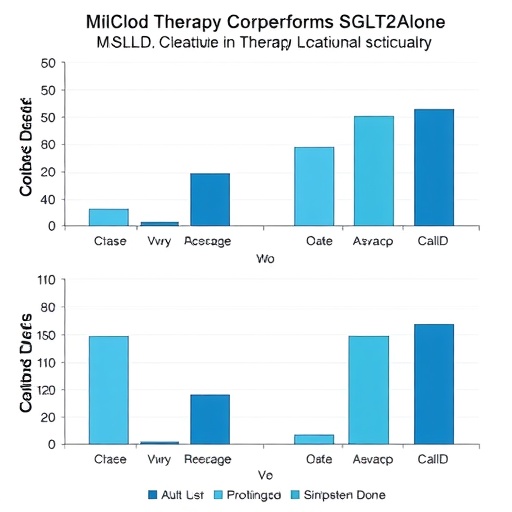
In the relentless pursuit of effective treatments for metabolic dysfunction-associated steatotic liver disease (MASLD), a groundbreaking study has emerged that may redefine therapeutic strategies and open new frontiers in metabolic medicine. Recent research led by Wu et al., published in Nature Communications, offers a compelling retrospective analysis comparing the efficacy and safety profiles of a combination therapy involving glucagon-like peptide-1 receptor agonists (GLP-1 RAs) and sodium-glucose cotransporter-2 inhibitors (SGLT2is) versus SGLT2 inhibitor monotherapy in patients with MASLD. This comprehensive investigation not only elucidates potential synergistic benefits of dual pharmacologic intervention but also bridges critical gaps in our understanding of the metabolic pathways modulated by these agents.
MASLD, formerly known as nonalcoholic fatty liver disease (NAFLD), represents a spectrum of hepatic disorders profoundly linked to insulin resistance, obesity, and type 2 diabetes mellitus (T2DM). Characterized by excessive lipid accumulation in hepatocytes, MASLD harbors significant risk of progression to nonalcoholic steatohepatitis (NASH), cirrhosis, and hepatocellular carcinoma. Therapeutic options remain limited, with lifestyle modification being the cornerstone. Yet pharmacotherapy targeting intricacies of the disease presents an urgent clinical need, particularly for high-risk patients. Against this backdrop, GLP-1 receptor agonists and SGLT2 inhibitors, originally developed for glycemic control, have garnered attention for their pleiotropic metabolic actions extending beyond glucose lowering.
GLP-1 receptor agonists function by enhancing glucose-dependent insulin secretion, slowing gastric emptying, and promoting satiety, collectively attenuating hyperglycemia and facilitating weight loss. Furthermore, preclinical studies suggest GLP-1 RAs possess hepatoprotective properties by mitigating lipotoxicity and inflammation, mechanisms critical in MASLD pathophysiology. Conversely, SGLT2 inhibitors act by promoting urinary glucose excretion via inhibition of sodium-glucose co-transport in the renal proximal tubules, reducing hyperglycemia independent of insulin secretion. Their benefits include reductions in body weight, blood pressure, and improvements in cardiovascular outcomes. Intriguingly, both drug classes influence hepatic steatosis and fibrosis, albeit through partially overlapping yet distinct molecular pathways.
.adsslot_TnGXyxIQi1{width:728px !important;height:90px !important;}
@media(max-width:1199px){ .adsslot_TnGXyxIQi1{width:468px !important;height:60px !important;}
}
@media(max-width:767px){ .adsslot_TnGXyxIQi1{width:320px !important;height:50px !important;}
}
ADVERTISEMENT
Wu and colleagues’ study retrospectively analyzed clinical data from a cohort of patients with MASLD, stratifying cohorts based on monotherapy with SGLT2 inhibitors or combination therapy with both GLP-1 receptor agonists and SGLT2 inhibitors. This design enabled researchers to evaluate longitudinal outcomes pertaining to hepatic structure and function, glycemic control, as well as cardiometabolic parameters. Advanced imaging modalities were employed to quantify changes in liver fat content, while biochemical markers provided insights into inflammatory and fibrotic processes within the hepatic microenvironment. The robust dataset allowed meticulous adjustment for confounding variables including baseline disease severity, concurrent medications, and comorbidities.
The findings revealed that combination therapy conferred superior reductions in hepatic steatosis compared to SGLT2 inhibitor monotherapy. Patients receiving concomitant GLP-1 RA treatment demonstrated not only greater declines in liver fat percentage but also improvements in liver stiffness measurements, indicative of attenuated fibrosis. This suggests that GLP-1 receptor agonists may potentiate the beneficial effects of SGLT2 inhibitors by engaging complementary mechanisms—such as enhanced insulin sensitivity, anti-inflammatory signaling, and direct modulation of hepatic stellate cell activity. Metabolic parameters including HbA1c, body mass index, and lipid profiles also reflected more favorable trajectories under dual therapy, underscoring systemic metabolic amelioration.
Another pivotal observation was the safety and tolerability profile of combination therapy. Despite concerns about polypharmacy, the incidence of adverse events remained comparable between the two groups. Gastrointestinal side effects typical of GLP-1 RAs were mild and transient, while the risk of genitourinary infections associated with SGLT2 inhibitors did not escalate with combination use. This bodes well for clinical implementation, particularly in the nuanced management of MASLD patients who often harbor multiple metabolic derangements and are susceptible to drug interactions.
Intriguingly, this study lends important mechanistic insights that could steer future therapeutic development. The synergistic action observed suggests that targeting both incretin and renal glucose handling pathways can more effectively restore metabolic homeostasis and halt liver disease progression. This synergism likely arises from convergent modulation of glucose, lipid metabolism, and inflammatory cascades. The GLP-1 receptor-mediated enhancement of mitochondrial function and suppression of endoplasmic reticulum stress might complement the SGLT2 inhibitor’s glucosuric effect, cumulatively providing a robust hepatic protective effect.
Given the rising global prevalence of MASLD and its association with cardiovascular morbidity, the implications of these findings are expansive. The cardio-renal-metabolic axis modulated by these drugs signifies that dual therapy could not only protect the liver but also mitigate cardiovascular risk factors prevalent in MASLD populations. This aligns with emerging paradigms advocating for integrated management of metabolic and hepatic diseases, thus catalyzing a shift toward combination approaches in clinical practice.
Nonetheless, the retrospective nature of the study poses inherent limitations, particularly with regard to causal inferences and potential selection bias. Prospective randomized controlled trials are warranted to validate these observations and to establish standardized treatment protocols. Moreover, delineation of patient subgroups who might derive the greatest benefit from dual therapy remains a critical research avenue. Biomarkers predictive of therapeutic response, pharmacogenomic profiling, and longitudinal safety monitoring will be essential components of future investigations.
It is also vital to consider the pharmacoeconomic implications of combination therapy. While both GLP-1 receptor agonists and SGLT2 inhibitors are cost-intensive medications, their potential to arrest or reverse MASLD progression may translate into reduced healthcare burden by preventing downstream complications such as cirrhosis or hepatocellular carcinoma. Health economic analyses incorporating quality-of-life metrics and cost-effectiveness will be instrumental in guiding policy and clinical decision-making.
The role of lifestyle intervention remains irreplaceable; however, these findings reinforce that adjunct pharmacotherapy targeting molecular pathways could offer an effective bridge for patients struggling to achieve optimal metabolic control. Integration of pharmacologic and lifestyle strategies tailored to individual risk profiles embodies the future of personalized medicine in hepatology.
Furthermore, the complex interplay between gut-liver axis, incretin hormones, and renal glucose handling underscores the importance of system-wide perspectives in therapeutic design. Targeting multiple facets simultaneously, as demonstrated by the combination of GLP-1 RAs and SGLT2 inhibitors, could serve as a prototype for multifactorial interventions in other metabolic-driven diseases.
Building on this foundation, pharmaceutical research might explore novel co-formulations or next-generation agents that harness and amplify these synergistic pathways. The potential also exists to investigate the addition of other metabolic modulators such as FXR agonists or PPAR agonists, broadening the therapeutic arsenal against MASLD.
In summary, this retrospective analysis by Wu et al. delivers compelling evidence that combination therapy with GLP-1 receptor agonists and SGLT2 inhibitors surpasses monotherapy with SGLT2 inhibitors in improving liver fat content, fibrosis, and overall metabolic health in MASLD patients. These insights pave the way for new standards of care that align with the complex metabolic derangements driving MASLD, promising enhanced patient outcomes through targeted molecular therapies. As the landscape of metabolic liver disease management evolves, the integration of combination pharmacotherapy represents a paradigm shift toward holistic, mechanism-based treatment strategies with profound clinical and societal impact.
Subject of Research:
Article Title:
Article References:
Wu, JY., Hsu, WH., Kuo, CC. et al. A retrospective analysis of combination therapy with GLP-1 receptor agonists and SGLT2 inhibitors versus SGLT2 inhibitor monotherapy in patients with MASLD. Nat Commun 16, 7459 (2025). https://doi.org/10.1038/s41467-025-62891-8
Image Credits: AI Generated
Tags: clinical implications of metabolic medicinecombo therapy for MASLDdual pharmacologic interventionGLP-1 receptor agonists benefitsinsulin resistance and liver diseasemetabolic dysfunction treatment strategiesmetabolic pathways in liver diseaseNASH progression risk factorsnonalcoholic fatty liver disease managementpharmacotherapy for high-risk MASLD patientsretrospective analysis of MASLD treatmentsSGLT2 inhibitors efficacy





